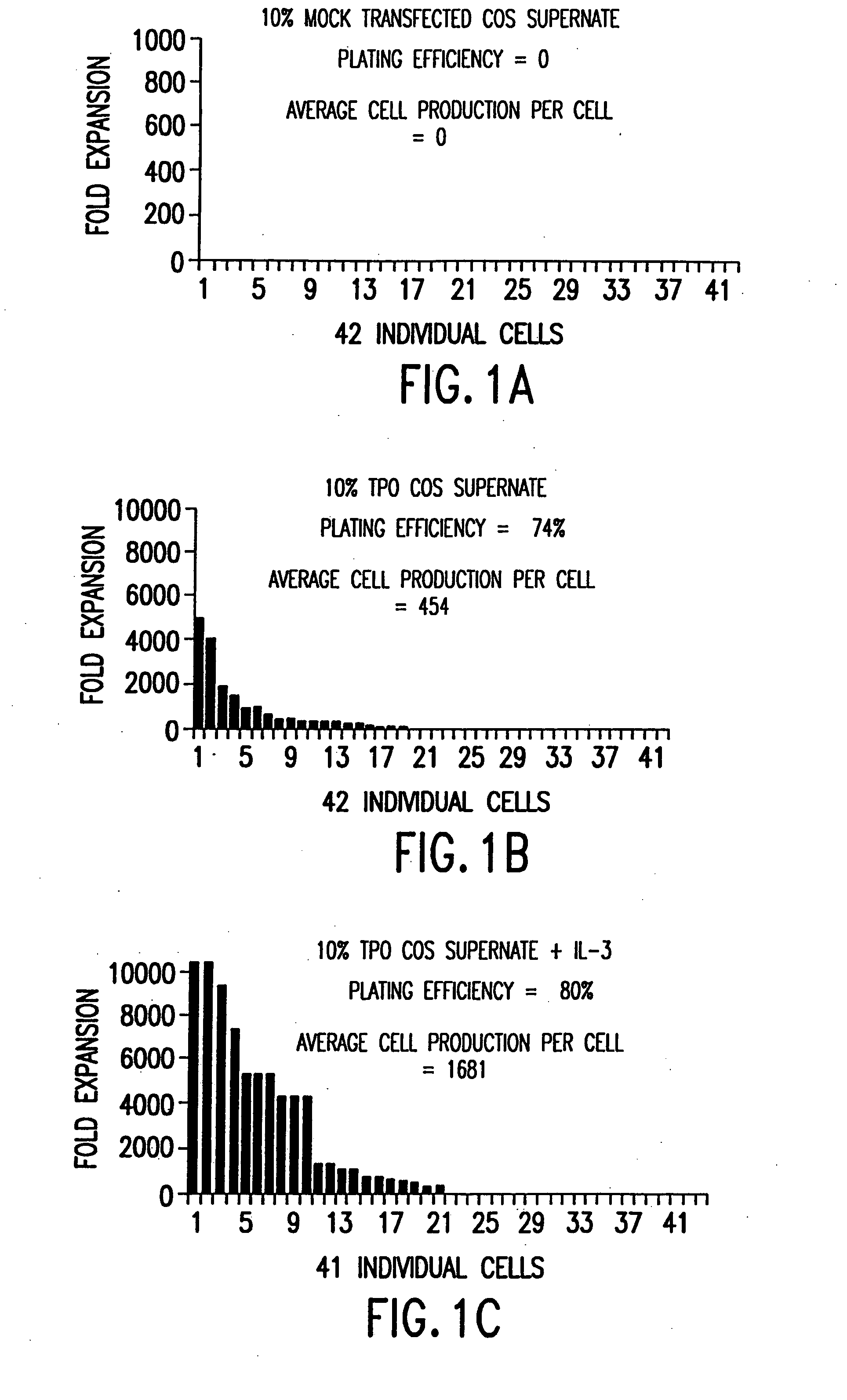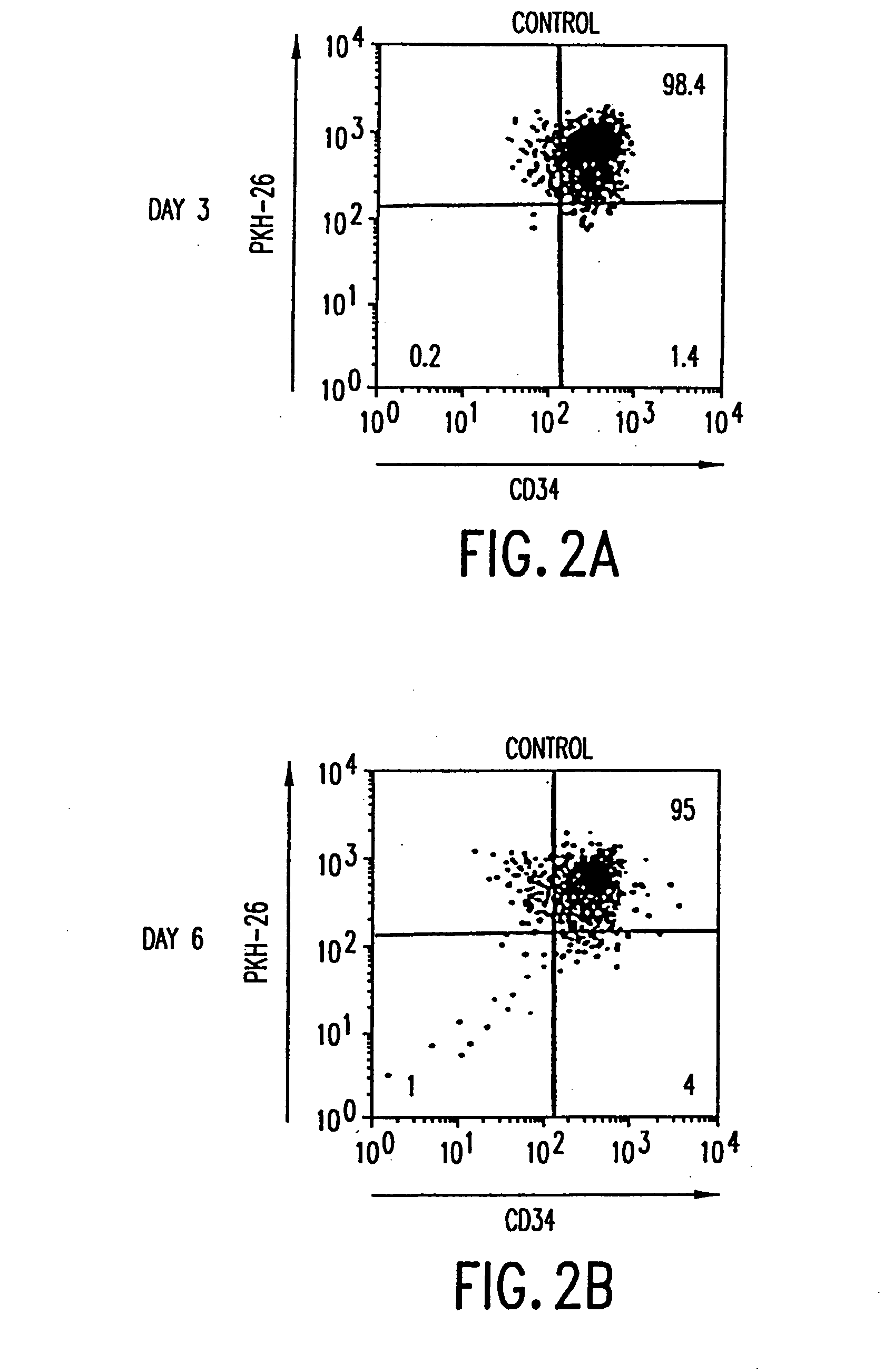Methods for use of MPL ligands with primitive human stem cells
a technology of primitive human stem cells and ligands, which is applied in the field of myeloproliferative receptors (mpl), can solve the problems of limited ability of progenitor cells to undergo multi-lineage differentiation, loss of self-renewal ability, and little knowledge of the actions of tpo on primitive cells prior to the onset of differentiation
- Summary
- Abstract
- Description
- Claims
- Application Information
AI Technical Summary
Benefits of technology
Problems solved by technology
Method used
Image
Examples
example 1
Cloning and Expression of Thrombopoietin
[0079] TPO cDNA was cloned using the polymerase chain reaction from human fetal liver cDNA (Clontech, Palo Alto, Calif.), using oligonucleotides based on the published sequence (de Sauvage et al. (1994) supra.), and expressed in COS cells. TPO-containing COS supernatants were shown to be active in stimulating the proliferation of mpl-expressing BaF3 cells (activity was 3×105 U / ml, where 50 U / ml=50% maximum activity), which were constructed by stable transfection of BaF3 cells with a human mpl expression construct as previously described (de Sauvage et al. (1994) supra). Mock transfected COS supernatant (COS control) was harvested from COS cells transfected with an empty expression vector, and had no effect on the proliferation of BaF3 cells.
example 2
Cell Selection
[0080] Enrichment of progenitor cells from human adult bone marrow and mobilized peripheral blood. Human adult bone marrow (ABM) CD34+ cells were enriched as follows. Briefly, fresh 20 ml bone marrow aspirates from normal volunteer donors were obtained from Stanford University Medical Center (Palo Alto, Calif.) or Scripps Research Institute (La Jolla, Calif.). Mononuclear cells (densityPasteurella haemolytica used for the bead release step in this procedure has been shown not to effect subsequent ex vivo expansion of progenitors (Marsh et al. (1992) Leukemia 6:929).
[0081] Stem cells were mobilized into the peripheral blood (MPB) of multiple myeloma patients and collected by leukapheresis as described by Murray et al. (1995) supra. MPB CD34+ cells were enriched from leukapheresis products by using a procedure involving elutriation, phenylmethylester lysis of granulocytes, and ammonium chloride lysis of red blood cells and CD34 positive selection as described by Suthe...
example 3
PCR Detection of MPL in Bone Marrow and Mobilized Peripheral Blood Samples.
[0087] Cell lysates were prepared from total human bone marrow cells and bone marrow or mobilized peripheral blood cells of the phenotypes CD34+Thy-1+Lin− (Thy+) and CD34+Thy-1−Lin− (Thy−), isolated as described in Example 2. RNA was prepared using RNA STAT60 (Tel-Test, Inc.) according to the manufacturer's instructions. CDNA was made from each of the RNA samples using BRL Superscript RT following the manufacturer's instructions. One-fifth of the cDNA was then used for the first degenerate PCR reaction. The degenerate PCR primers designed to amplify sequences related to the Epo receptor and mpl receptor of the class I hemopoietin receptor family are as follows:
(SEQ ID NO:1)Sense primer HEpM1-5:5′-GCTATTGCGGCCGCGAATTCGGARGAYYTIINITGYTTYTGG-3′(SEQ ID NO:2)Antisense primer HEpM2-3:5′-GCTATTCTCGAGATCGATSWCCAITCRCTCCAIIINCC-3′(SEQ ID NO:3)Antisense primer HEpM3-3:5′-GCTATTCTCGAGATCGATSWCCAINIRCTCCAIIINCC-3′
[00...
PUM
| Property | Measurement | Unit |
|---|---|---|
| concentration | aaaaa | aaaaa |
| concentration | aaaaa | aaaaa |
| concentration | aaaaa | aaaaa |
Abstract
Description
Claims
Application Information
 Login to View More
Login to View More - R&D
- Intellectual Property
- Life Sciences
- Materials
- Tech Scout
- Unparalleled Data Quality
- Higher Quality Content
- 60% Fewer Hallucinations
Browse by: Latest US Patents, China's latest patents, Technical Efficacy Thesaurus, Application Domain, Technology Topic, Popular Technical Reports.
© 2025 PatSnap. All rights reserved.Legal|Privacy policy|Modern Slavery Act Transparency Statement|Sitemap|About US| Contact US: help@patsnap.com



